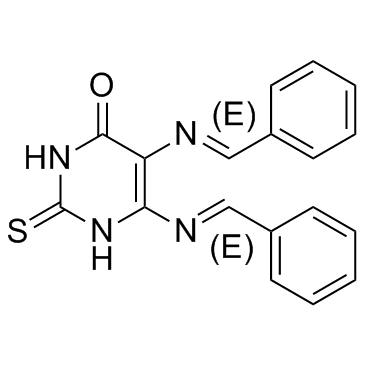1533426-72-0
| Name | scr7 |
|---|---|
| Synonyms |
5,6-Bis[(E)-benzylideneamino]-2-sulfanyl-4-pyrimidinol
SCR 7 4-Pyrimidinol, 2-mercapto-5,6-bis[[(1E)-phenylmethylene]amino]- 5,6-bis((E)-benzylideneamino)-2-thioxo-2,3-dihydropyrimidin-5,6-bis((E)-benzylideneamino)-2-thioxo-2,3-dihydropyrimidin-4(1H)-one SCR-7 |
| Description | SCR7 is a DNA Ligase IV inhibitor with anticancer activity. |
|---|---|
| Related Catalog | |
| Target |
DNA Ligase IV CRISPR/Cas9 |
| In Vitro | SCR7 inhibits joining of double-strand breaks (DSBs) in cell-free repair system. SCR7 blocks Ligase IV-mediated joining by interfering with its DNA binding but not that of T4 DNA Ligase or Ligase I. SCR7 inhibits NHEJ in a Ligase IV-dependent manner within cells, and activates the intrinsic apoptotic pathway. Results show a dose-dependent decrease in cell proliferation of MCF7, A549, and HeLa with an IC50 of 40, 34, and 44 μM, respectively, which is further confirmed by DIC imaging in MCF7. T47D, A2780, and HT1080 are also sensitive to SCR7, with an IC50 of 8.5, 120, and 10 μM, respectively[1]. |
| In Vivo | SCR7 treatment (10 mg/kg, six doses) significantly reduces breast adenocarcinoma-induced tumor. Untreated tumor animals survived only for 52 days, whereas treated animals exhibit ~4-fold increase in lifespan[1]. |
| Cell Assay | Wild-type, AAVS1TLR HEK293 and mouse NIH3T3 cells are maintained in DMEM supplied with 15% FBS, cells are passaged three times per week. The mouse Burkitt lymphoma cell line, generated from a Burkitt-like mouse lymphoma is maintained in DMEM supplied with 15% FBS, 2 mM HEPES, 2 mM sodium pyruvate, 2 mM L-glutamine, and 1× NAA, beta-mercaptoethanol and passaged four times per week. For puromycin selection, mCherry+ cells are sorted, seeded at 103 cells/well and selected with 3 mg/mL of Puromycin for 2 weeks. Then colonies are counted and single cells are sorted. The SCR7 inhibitor is purchased, 12 h after transfection these cells are maintained in complete medium supplied with 1 mM SCR7 inhibitor until analysis. At SCR7 concentrations of 60 mM and 10 mM, A reduction of transfection efficiency and of cell viability is observed[3]. |
| Animal Admin | Mice[1] BALB/c mice are injected with DLA cells (0.25×106) intraperitoneally for tumor development, after which two batches of animals are divided into eight subgroups. Treatment is started after 5 days of DLA injection (d 0). Group I serves as tumor control (n=10). Group II (IR, n=5) and III (IR+SCR7, n=5) receive two doses of radiation (2 Gy) on day 0 and 4. Besides radiation, Group III also receives six doses of SCR7 (20 mg/kg) on alternate days from day 0. Group IV (Etoposide, n=5) and V (Etoposide+SCR7, n=5) received three doses of Etoposide (10 mg/kg) intraperitoneally on day 0, 4, and 8. In addition to Etoposide, Group V animals also receive six doses of SCR7 (20 mg/kg) on alternate days from day 0. Group VI (3-ABA, n=5) and VII (3-ABA+SCR7, n=5) received three doses of 3-Aminobenzamide (10 mg/kg) on days 0, 4, and 8. Group VII receives six doses of SCR7. Group VIII (SCR7, n=5) receives six doses of SCR7 alone (20 mg/kg) on alternate days (0, 2, 4, 6, 8, and 10) and serves as the control. Progression of tumor is monitored and data are presented as a bar diagram. Error bars and levels of significance are indicated in respective figure legends. |
| References |
| Density | 1.3±0.1 g/cm3 |
|---|---|
| Boiling Point | 644.9±65.0 °C at 760 mmHg |
| Molecular Formula | C18H14N4OS |
| Molecular Weight | 334.395 |
| Flash Point | 343.8±34.3 °C |
| Exact Mass | 334.088837 |
| PSA | 105.46000 |
| LogP | -0.22 |
| Vapour Pressure | 0.0±2.0 mmHg at 25°C |
| Index of Refraction | 1.675 |
| Storage condition | 2-8℃ |
